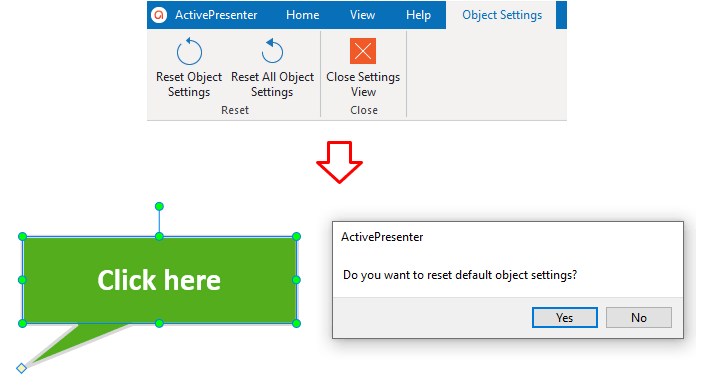You may get familiar with working with the Object Settings to create default objects and reuse them later. Now, ActivePresenter 9 brings you enhancements to make you optimize your work. Learn more in today’s article.
As you may know, the Object Settings feature comes with ActivePresenter 8 release version. It helps users save tons of time to create the same objects’ properties for courses, projects, and quizzes. That’s because it keeps all the information, color, and style even if you change its shape. After customizing objects in the Object Settings view, newly inserted objects of the same type will inherit all the properties that you have adjusted. Besides, this feature enables you to decide the position of your object flexibly. This is the difference between Object Settings and Slide Masters.
The article covers 4 main parts as follows:
Download the app here to unlock your creativity!
Overview of Object Settings
To open the Object Settings view, just access the View tab > Object Settings.

As can be seen, the Object Settings View includes three main parts:
- The Objects Settings tab’s toolbar contains commands for editing default objects.
- The left pane consists of 14 object types, namely Shapes, Gesture Effect, Mouse Click, Key Stroke, Text Entry, Drop Area, Button, Checkbox, Radio Button, Slider, Dropdown, Timers, Cursor Path, and Questions. Each object type has its own default object.
- The Canvas previews the changes when you customize default objects.
Note: Shapes, Gesture Effect, Timers, and Questions have their own object types.
Customize Default Objects in Object Settings
When it comes to setting default objects, you can right-click the object on the Canvas and select Set as Default. However, in case you haven’t created any object on the Canvas, working with Object Settings is your solution.
Now, to customize any default object, take the following steps:
Step 1: Click on object type on the left pane. The default object will appear on the Canvas.
Step 2: Select the object and change its color and appearance, add text, add events – actions, and more (Go to the object’s Properties pane or the Format tab). The Canvas will show all the changes you made to the object.
Step 3: Click Close Settings View to save everything and close the view. All newly added objects of the same type in the current project will inherit the alterations.
Save Objects Across Projects
In case you want to reuse the customized objects for other projects, adding them to Object Templates or saving them as Custom Themes are good choices. Here’s how:
Step 1: Click ActivePresenter > Save or Save as….
Step 2: Select ActivePresenter Object Template (*.apobject) in the Save as type list. Alternatively, you can select ActivePresenter Theme (*.aptheme).
Step 3: Click Save.
Normally, your file saves in (C:\Users\<user_name>\Documents\ActivePresenter Templates (for Windows) or /Users/<user_name>/Documents/ActivePresenter Templates (for macOS)).
Reset Default Object Settings
If you aren’t satisfied with the changes after customizing, ActivePresenter 9 allows you to reset. The app offers you two options:
- Reset an individual object: click Reset Object Settings in the Objects Settings tab’s toolbar > select Yes on the pop-up dialog. Alternatively, right-click the object > Reset Default Settings.

- Reset all default object settings: click Reset All Object Settings in the Objects Settings tab’s toolbar > select Yes in the pop-up dialog.
It is easy to work with Object Settings, isn’t it? Give ActivePresenter 9 a try to speed up your workflow. Visit our YouTube channel to get more tutorial videos. Have any problems? Feel free to contact us.
More Articles:

